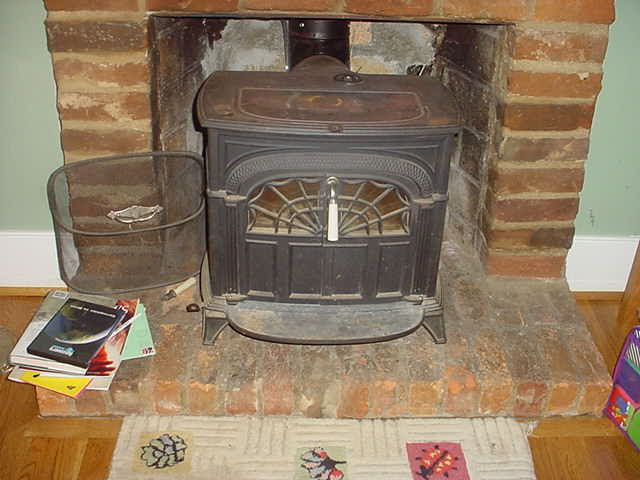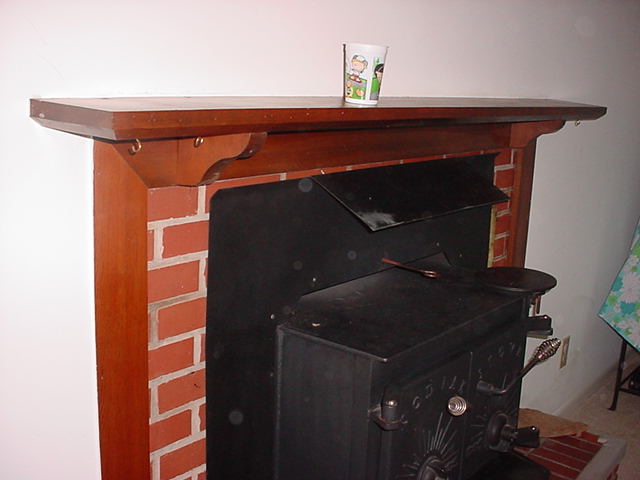The trouble with wood burning fireplace inserts!
Do any of these look familiar?






They do? Then Read On Brother, Read On!
If you have a wood burning fireplace insert and it has been in place for a while, the chances of that insert being “properly” installed are “slim to none!” By “properly”, I am referring to a stove installation that adheres to NFPA (National Fire Protection Association) 211 Standards.
Most fireplace inserts are simply “pushed” (shoved is more like it) into the opening of a fireplace (we refer to these as “slammed in” or “slammers”) and they are very dangerous!
The “Backstory”
In the late 70’s and early 80’s, we were going through yet another “energy crisis”, where oil and gas prices were sky high. Everyone, including me, thought they could install a wood burning fireplace insert in their home and eureka! “CHEAP HEAT!”
It was not until there was a dramatic rise in the number of house structure fires where fireplace inserts had been installed that the practice of insert “slamming” was looked at and investigated more closely. Such entities as the NFPA (National Fire Protection Association) the WHA (Wood Heat Alliance) and the NCSG (National Chimney Sweep Guild) became involved. It was discovered that there were some very large inherent issues associated with installing an wood burnin fireplace insert in such a fashion.
So what was the big deal?
In a nutshell, the flue of the fireplace was over sized to properly vent a stove! What! How can that be? Bigger is always better, right? Wrong! Wrong! Wrong! When it comes to venting technology, bigger is not better. In fact, it can be downright dangerous, sometimes resulting in deadly consequences.
The why of this problem!
A wood stove insert (typically) vents through an exhaust (flue) opening 6″ in diameter (example only, some stoves may use an 8″ flue), which is 28 sq. in. A fireplace flue is built, at a minimum (by code), with a ceramic flue tile that is 13″ x 13″ O.D. (Outer Diameter). A 13″ x 13″ flue tile has an 11″ x 11″ I.D. (Inner Diameter). OK, math time! 11″ x 11″ = 121 sq. in. This is approximately 4 times the flue exhaust area that is needed to vent the stove correctly! This sizing differential issue leads to several (potentially dangerous) issues.
1) Temperature Variance within the flue stack
The “hot” smoke and gases that exit the stove at a “normal” temp of 600-800 degrees, is travelling through a much colder (relatively) masonry (brick) chimney flue system. Remember this! A typical brick chimney sits on the outside of most homes and is the temperature that it was yesterday! (Think large “thermal mass”) Now lets discuss creosote. We will get back to the temperature thing in a moment.
Creosote is the byproduct of burning wood. It can be defined as a combustible deposit that is, to put it simply, “condensed smoke”. Smoke, believe it or not, is mostly water vapor! Yep! Good ‘ole H2O! This water vapor contains all the unburned hydrocarbons and all the other nasties the fire does not consume. So think of smoke as a “tar fog”. Remember that nothing can burn 100%. There will always be some sort by-product in the combustion process ( called pyrolization). This tar fog becomes creosote as it condenses and accumulates on the ceramic flue tiles of the chimney as it makes it’s way to the outside atmosphere.
Smoke (aka “heat”), as is nature’s way, travels upward in a “spiral”. A brick chimney’s flue is (normally) square or rectangular. Therefor, smoke is continually colliding with the flue walls on its journey to the outside atmosphere. This “colliding” action is called “resistance to flow” and anywhere that the hot smoke touches the cold surface of the flue it will condense and stick. Now you have creosote and it can form into a gooey, gummy, drippy mess. This gooey, gummy, drippy mess is now the “fuel” of a chimney fire! This is why it is important to have a wood burning fireplace insert installed with its own round, properly sized and insulated chimney liner (pipe). When the correct insulated chimney liner is installed, there is far less resistance to flow and very little temperature variation within the venting system, therefor, although creosote is not eliminated, it is drastically reduced.
2) Residence Time
This is “how long” the smoke takes to exit the flue system. Of course, you are trying to make this as short a time as possible. That can only be accomplished by abiding by the recommendations put forth by the NFPA 211 Standards. Installing the stove with a properly sized, insulated chimney liner!
Now, let’s discuss insurance!
A major consideration (and concern) about a stove not installed to NFPA National Fire Protection Association 211 Standards is whether you are covered by your homeowners insurance policy. After 36 years in the chimney maintenance industry, I am not aware of any insurance company that covers an improperly installed wood burning fireplace insert. My advise to you would be 1) check to see if your fireplace insert is installed properly (if you are not be sure to call us, we will conduct a complete inspection) or 2) talk to your insurance carrier to see if you are covered!
Don’t get burned, by your improperly installed stove or by your insurance company!


